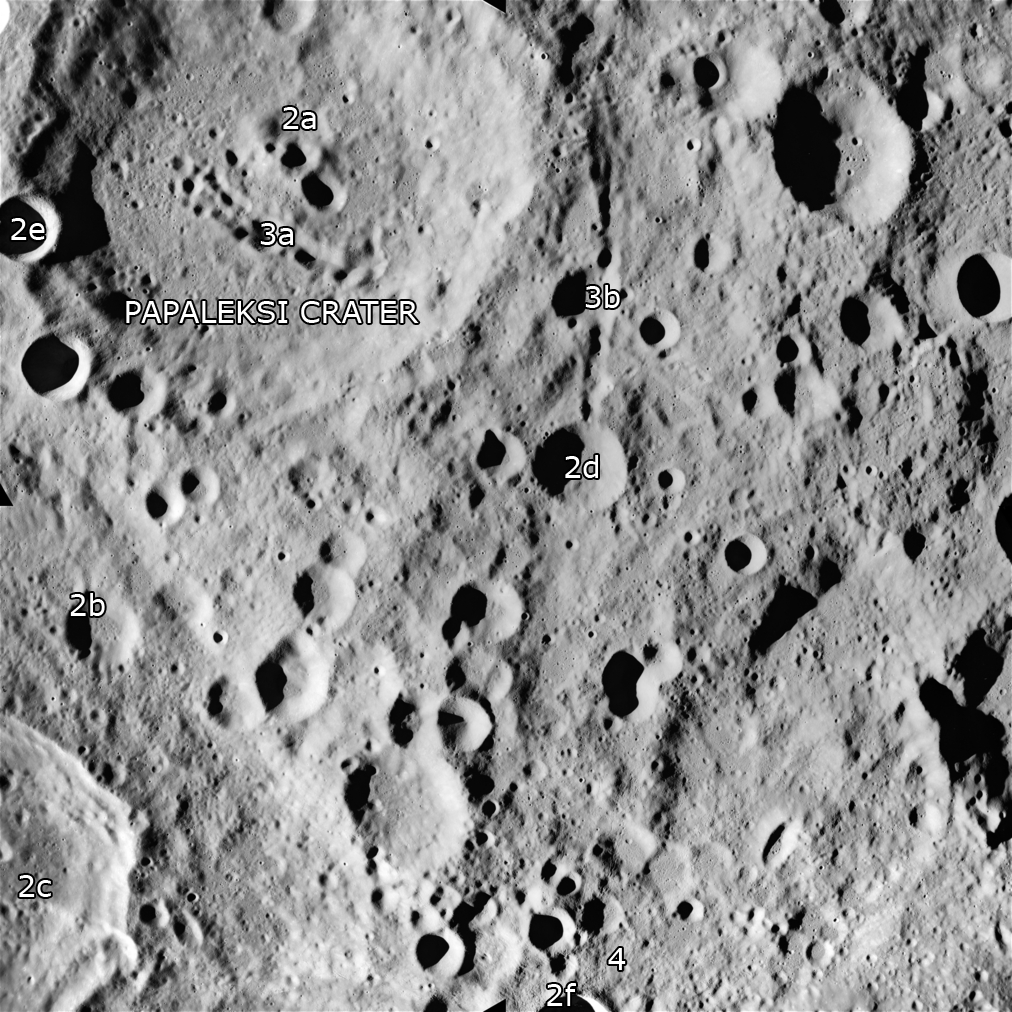
| Project Home | About the Scans | Browse Gallery | Image Map | Support Data | Resources | Ephemeris |
Featured Image - 05/04/2009
Cratering: Degradation, ejecta blankets and strings
Impact craters dominate the morphology of the lunar surface, especially in the lunar highlands. Over time, a continuous rain of impacts creates new craters while causing the degradation or outright destruction of older impact craters. Larger impacts can obliterate pre-existing features that were at the center of the impact. Smaller impacts also obliterate local surface areas, but accumulating small impacts on significantly larger features (e.g., mountains and craters) will progressively degrade the older and larger features. The airless lunar surface is also constantly subjected to bombardment from small, micron-sized particles (which would be burnt up in Earth's atmosphere) that erode every exposed surface on the Moon over aeons of geologic time. Figure 1 shows a region of the lunar surface surrounding Papaleksi crater that has been subjected to impact cratering over hundreds of millions of years. This bombardment history can be unraveled to some extent by studying the size and degrees of degradation of the impact craters in this region.
Figure 1. Apollo 16 Metric Camera frame AS16-M-0040 showing a region with many craters of varying degrees of degradation and, therefore, ages. Papaleksi crater is labeled in the upper right. The numbers refer to sections shown in Figures 2-4. This Metric frame was taken on orbit 17 with a Sun elevation of 14 degrees on April 20, 1972, from an altitude of 118 km. (Apollo Image AS16-M-0040 [NASA/JSC/Arizona State University]).
Figure 2. Sample craters from Figure 1 showing the various degrees of degradation in this region, from most degraded to least, indicating oldest to youngest. (a) 84 km diameter crater with many superposed smaller craters. (b) 12 km diameter crater with superposed craters yet on top of any ancient ejecta from crater in (a). (c) 61 km diameter crater, known as Mandel'shtam crater, has a more distinct rim yet still many smaller superposed craters. (d) 15 km diameter crater with more intact rim and less superposed craters. (e) 12 km diameter crater with some ejecta blocks around the rim and very few superposed craters. (f) 14 km diameter crater with many ejecta blocks and obvious ejecta ray radially oriented from the crater. Very few impacts are superposed on crater (f) and its associated ejecta blanket.
Figure 3. Strings of craters, or crater chains, from Figure 1. (a) East-west trending crater chain on the floor of Papaleksi crater. (b) North-south trending (north to the left) crater chain just east of Papaleksi crater. These crater chains are likely the result of secondary impact structures from debris ejected out during the formation of large nearby craters or basins. The chains could also be primary in nature from a bolide that broke into pieces before impact but traveled nearly the same trajectory up to the point of impact.
Figure 4. A relatively fresh ejecta blanket from a crater barely visible on the southern edge of Figure 1. The rim of the crater is the bottom-most part of the subframed area in this figure. The blocky features near the bottom are ejecta blocks from the underlying material. The blocks become smaller toward the north (up). As the ejecta blanket was laid down during the impact, linear features continue outward as the radial dispersion of material from the point of impact. Only a few craters no more than tens of meters in diameter are superposed onto the ejecta blanket.
The upcoming Lunar Reconnaissance Orbiter Camera will provide insight into the formation relationships of lunar craters all over the Moon by imaging examples from the full continuum of lunar impact craters (from old, degraded craters to fresh, well-formed craters) at many locations on the Moon's surface at 0.5 m/pixel resolution.
References:
The New Solar System, eds. Beatty, J.K., C.C. Petersen, A. Chaikin, Cambrige University Press, 1999.
(Apollo Image AS16-M-0040 [NASA/JSC/Arizona State University])

|
|
Space Exploration Resources |
|
 LPI LPI
|



